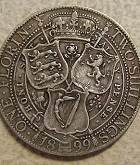
Background
The drive for decimalisation of the currency in Britain dates as far back as 1682. Although nothing was done regarding early proposals, the adoption of a decimal currency in the United States, France and other nations in the late 18th and early 19th centuries renewed the call, and commissions in 1841 and 1843 called for its adoption. In 1847, a motion was introduced in Parliament by Sir John Bowring calling for the introduction of a decimal currency and the striking of coins of one-tenth and one-hundredth of a pound. Bowring obtained surprisingly strong support for his motion, and the Russell government promised that a coin valued at one-tenth of a pound (two shillings) would be produced to test public opinion, with consideration in future to be given to the introduction of other decimal coins.
There was much discussion about what the coin should be called – centum, decade, and dime being among the suggestions – before florin was eventually settled upon, not because of the old English coin of that name, but because the Netherlands had a florin, or gulden, about that size and value. The original florin, the fiorino d'oro of the Republic of Florence, was a gold coin struck from 1252 to 1533.